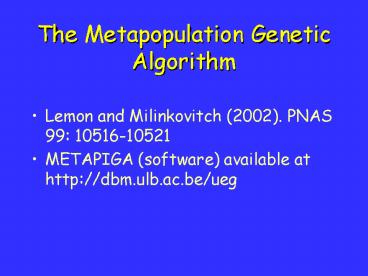The Metapopulation Genetic Algorithm - PowerPoint PPT Presentation
1 / 13
Title:
The Metapopulation Genetic Algorithm
Description:
Individuals allowed to reproduce with a prob. ... When all topological changes allowed have been attempted but no improvement was achieved ... – PowerPoint PPT presentation
Number of Views:97
Avg rating:3.0/5.0
Title: The Metapopulation Genetic Algorithm
1
The Metapopulation Genetic Algorithm
- Lemon and Milinkovitch (2002). PNAS 99
10516-10521 - METAPIGA (software) available at
http//dbm.ulb.ac.be/ueg
2
Genetic algorithms
- Matsuda (1996), Lewis (1998), Katoh et al (2001),
Foster (2001) - A type of evolutionary computational method
- Mimic processes of biological evolution such as
mutation, recombination, selection, and
reproduction
3
Genetic algorithms
- Initial step generate a population of
individuals (specific solutions to a problem) - Individuals within a population are subjected to
mutation and/or recombination - Individuals allowed to reproduce with a prob.
that is function of their relative fitness
value - Mean score of population improves over time
4
MetaGA essence of the procedure
- Coexistence of two or more populations
interacting in a metapopulation setting - Parallel searches allow significant
inter-population variation in spite of strong
selection - But populations are not fully independent, they
are forced to cooperate
5
MetaGA essence of the procedure
6
Consensus Prunning
- Communication between populations defines
topological operators - Assumption comparisons identify tree partitions
that are correct (and should not be modified) and
regions that still need to be resolved
7
Consensus Prunning
8
Consensus Prunning
- Random, ring, alternate ring, strict group
consensus, majority group consensus, probability
group consensus
9
Evaluation
- At the beginning of each generation, each tree is
evaluated - Evaluation does NOT involve optimization of
branch lengths or other model parameters - The logL is scored and recorded
10
Selection
- Rank by lnL Prob of leaving an offspring
2(n-i1)/(n(ni) - Tournament two indiv drawn at random, one
offspring is produced from the best (with
replacement) - Replacement similar, but two copies of the best
are produced (without replacement), sn times - Improve only better trees than previous best
will reproduce
11
Mutation
- Each individual, with the exception of the
current best from each population is subjected to
a single mutation - Topological mutations SPR, NNI, taxa swap (TS),
subtree swap (STS) - Branch Length mutations (BLM) only on internal
nodes - Recombination (RCM)
12
Starting Trees
- Jacknifed NJ (JNJ) overlapping and
non-overlapping - Noisy NJ (NNJ)
- Random (not recommended)
13
Stopping rule
- The overall number of consensus partitions
increases with search time - Search stops when
- Best trees of all populations have the same
topology, or.. - When all topological changes allowed have been
attempted but no improvement was achieved - User hits the stop button (or predefined of
generations has been reached)































